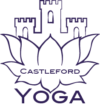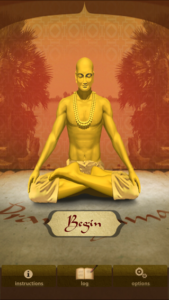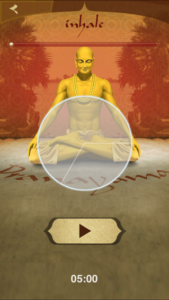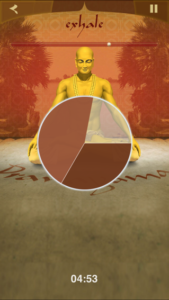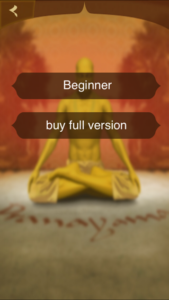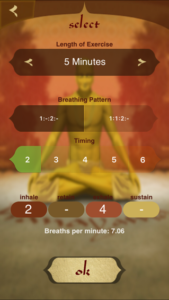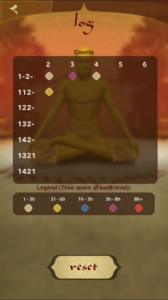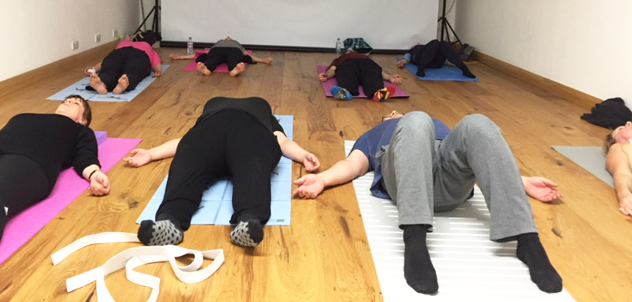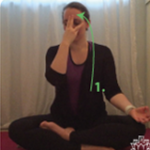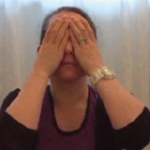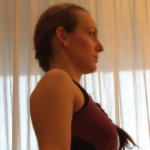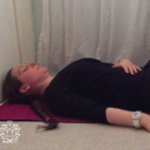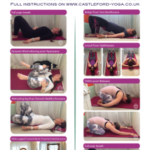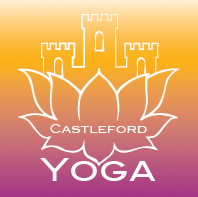
Let modern technology help you practice the ancient method of breath control – Pranayama.
We have looked at various pranayama exercises their benefits and techniques in the last few posts. Today, I’d like to introduce you to an App that I have been using for several years now to help me focus during pranayama practice as well as giving me statistics about my practice and show me improvements. Some say “if you don’t measure it you can’t improve it”; I think this may be true for some, especially in our modern, results-orientated world. Whether you like to track your efforts or just like extra guidance and a timed session this App can serve both.
The Pranayama App’s main function is to give you timed audio sounds to help you practice a particular rhythm of breathing. The sounds are soothing and it allows you to shut out the vision sense which I find is the most distracting one of all, the eyes are constantly searching for input to trigger new thoughts and feelings.
When you first open the App you choose your level of practice, for most I recommend starting with the Beginners level, it advances quite quickly and is very challenging at the longer breath ratios.
Now choose how long you want to practice for – 5min is the minimum duration you can choose, the maximum is 60mins. So you can see; between the breath ratios – lengthening in-and or exhale and the duration of practice you have plenty of challenges to keep your practice interesting for many many months.
Next, you decide on a breathing pattern, 1:0:2:0 or 1:1:2:0. The first number stands for the inhale, the 2nd for the internal retention (keeping the breath in the body) and the 3rd stands for the exhale. The 4th number is not used in the beginners level as it takes experience to be able to safely work on externally holding the breath – which means once you exhale you don’t inhale straight away, you don’t breath at all – there is a breath pause. This can trigger severe anxiety and stress in some people and should not be tried without an experienced pranayama practitioner at your side.
After you chose say a basic 1:0:2:0 breath pattern you chose the timing – the length which each part of the breath shall take. If you have never practiced before start with the 2 timing option which makes your inhale take 2 counts and the exhale 4 counts. There are no in or external retentions in this pattern. At the bottom of the settings page of the App you can see how many breath per minute your chosen timing and breath pattern equates to. Since we know that the average adult breathes 15-18x a minute without any pranayama practice you can bring this down through regular practice which makes your cardio respiratory system more efficient.
“Stillness is achieved by control of breath” – Hatha yoga pradipica, CH 2 vs 2
When the breath is unsteady, the mind is unsteady. When the breath is steady, the mind is steady and the yogi becomes steady. Therefore one should restrain the breath.” – Hatha yoga pradipica, CH 2 vs 1.2
So why should we practice pranayama or breath control other than that it makes us feel more relaxed, calm and centred?
In the teachings of yoga, it is believed that “disease is the slowdown of energy”. Remember we discussed the word prana or life force in the first post of this series. Bearing that in mind when we explore the concept of inspiration and expiration – both words are related to the word spirit. Inspiration is all about bringing spirit or life force into the body, Expiration is about letting go of the spirit – and if life force expires – life is no more. The presence of prana/ life force is said to be what distinguishes a living body from a dead one.
Because many of us breathe shallow, using little effort to breathe fully we don’t bring in much oxygen; neither do we clear out the carbon dioxide properly. We just don’t give our lungs the opportunity to do a thorough gaseous exchange deep in the lungs and the oxygen levels in the blood and at a cellular level drop causing the body stress because oxygen is needed for many metabolic processes. This triggers a constant fight for survival in the nervous system which will increase the breath rate to compensate for the reduced levels of oxygen (a threat to survival) – which can reduce the levels of carbon dioxide too far (when taken to the extreme we know this as hyperventilation) causing symptoms of dizziness, irritability and excessive sighing.
The shallow fast way of breathing is associated with feelings such as anxiety, neurosis, depression, phobic behaviour and high levels of stress both perceived and objective nature. Interestingly when people without those type of psychological tendencies adopted a shallow rapid breathing pattern they reported the same feelings of anxiety and distress as the people that are habitually breathing poorly.
Now we have a better understanding of how the breath pattern we unconsciously use leaves us feeling sluggish and lacking life force. The yogis live by the knowledge that “Breath is life. Life is breath”. We all know that breathing is absolutely essential to life, unlike food and water which we can live without for small periods of time. To remember how essential breathing is can help give it more prominence and bring it onto the list of things that really matter to us, knowing that our health, vitality, and emotional wellbeing relies on good efficient breathing consciously and unconsciously which is the case most of the time.
So next time you are feeling sluggish like you need a coffee, pick me up or a nap, take the time slowly soak up some fresh oxygen/ life force – you may not even need the “pick me up” anymore.
Breathing and chronic pain
If you suffer with chronic pain, chances are your natural breathing pattern has permanently altered as pain generally seizes up the breath altogether. We all know what happens when we chop vegetables and accidentally cut our finger, at first you kind of stop breathing with shock, then your heart rate increases and you probably gasp for air for a little while. From my experience with chronic inflammatory joint pain, I am well aware of how my breathing gets shallow and even stops just to try and mitigate a sudden pain signal – it doesn’t help, so I have spent a lot of time trying to breathe more consciously in those situations and found that it actually helps the pain to dissipate much better.
Interestingly, chronic neck/ shoulder tension can often be traced back to the fact that our stressful modern lives have us breathing rapidly using our chest and neck muscles rather than our respiratory muscles. In this case retraining the body to adopt a more diaphragmic breathing pattern can help alleviate chronic tension in the neck and shoulder muscles. Slow and steady breathing helps stimulate the parasympathetic nervous system which is responsible for slowing the heart rate and lowering the blood pressure – reducing stress levels and inducing relaxation.
“If you can enhance your breathing capacity, you can enhance your capacity for enjoying the world.”
– Meet your body by Noah Karrasch
The overall benefits of pranayama/ breathing exercises:
- relaxes the mind, reducing stress
- help experience a sense of union between mind, body and spirit
- helps improve focus and becoming more present
- reduces high blood pressure
- can improve asthma
- helps with lung problems
- increases lung capacity
- can improve snoring
- can significantly reduce anxiety
- can release muscular tension around the heart and digestive organs
- can release muscular tension around the neck and shoulders
- may help with insomnia
- improves detoxification through better exchange of carbon dioxide and oxygen
From an anatomy and physiology standpoint, improving your breathing efficiency affects the following:
Regular breathing practice increases your cardiovascular capacity, this is without having to actually exercise. Your resting and working heart rate decreases as the lung capacity increases. When the heart rate is higher, the diastole phase, during which the heart (relies on oxygen to function) is getting supplied with oxygen rich blood most effectively, decreases. This starves the heart muscles/ myocardium of oxygen. The imbalance of oxygen demand and supply is known as myocardial ischemia and typically results in chest pain commonly known as angina.
Heart rate reduces when the blood is rich in oxygen and the stroke volume is increased due to the heart muscle/ myocardium being stronger and better supplied with oxygen rich blood. The effectiveness of venous return also plays a role in how well the cardiovascular system functions. The pressure on the abdominal viscera from diaphragmatic breathing motion contributes to venous blood return to the heart which is an important determinant of cardiac output and efficiency.
Another part of the system becoming more efficient is the increase in blood volume and red blood cell count – increased haemoglobin levels improve oxygen carrying capacity of the red blood cells. Increased capillarisation allows for improved gaseous exchange both in the muscles and lungs.
Lets look at the actual air flow – tidal volume is the amount of air moved in and out of the lungs in one breath cycle. For example, during exercise the tidal volume increases to meet the increased oxygen demands and remove the increased level of carbon dioxide which is a by-product of aerobic metabolism. So training helps the muscles of breathing to become more efficient and the breathing rate decreases while the tidal volume increases which in the long term leads to improved exchange of gases both at rest and during activity.
We also need to consider the residual volume. It is known as “dead space” in the lungs – it is the amount of air left in the lungs after exhalation. It isn’t possible to ever empty the lungs fully because the residual volume is needed for continuous gaseous exchange between breath as well as keeping the lungs inflated enough to avoid friction or collapse. When exercise or exertion begins – residual volume decreases. This is due to the increase in tidal volume (more air moving in and out of the lungs in each breath). Residual volume and tidal volume have an inverse relationship. If tidal volume increases, residual volume decreases and vice versa.
As a longer term adaptation of breath training or cardiovascular training, the residual volume will also decrease at rest because the overall increase of the tidal volume – the ability to move greater amounts of air with each breath.
This is also called vital capacity – the maximum amount of air that can be forcefully in and exhaled in one breath. As both tidal and residual volumes improve, vital capacity increases too. Which helps the lungs maintain their elasticity.
So when you practice diaphragmatic breathing and work on improving the length of the in and exhale, your are working on increasing the tidal volume and decreasing the residual volume which means you are getting rid of your carbon dioxide more effectively. The longer, slower in and exhale also helps the lungs to have more time for the gaseous exchange – improving the body’s oxygen uptake overall. You are increasing the fitness of your cardiovascular system – your heart and lung complex.
The physical Benefits:
Short term benefits:
- increased tidal volume
- decreased residual volume
- increased efficiency of carbon dioxide removal and oxygen uptake
Long term benefits:
- decreased overall breath rate at rest and activity
- increased tidal volume – air moved with each breath
- decreased residual volume because of the increased use of dead space
- increased efficiency of carbon dioxide removal and oxygen uptake at rest and activity
- increased capillarisation improving gaseous exchange
- increased vital capacity
So you can see there is a lot more to practicing breathing control than that it makes you feel peaceful. When I looked at all the research for this article and carefully evaluated all the functions of good breathing I was most exited about the fact that it helps you improve your cardio respiratory function without having to jump around like crazy.
Now get practicing with deep abdominal breathing or full yogic breath, you can even do nadi shodhana to the Pranayama App timing.
I hope you find this post and the app helpful for developing your pranayama practice further, why don’t you drop me a line in a few days with an update on how you are getting on?
What does Pranayama do for you?
Or ask further questions if they come up.
I always love hearing from you.
Namaste
Marie
